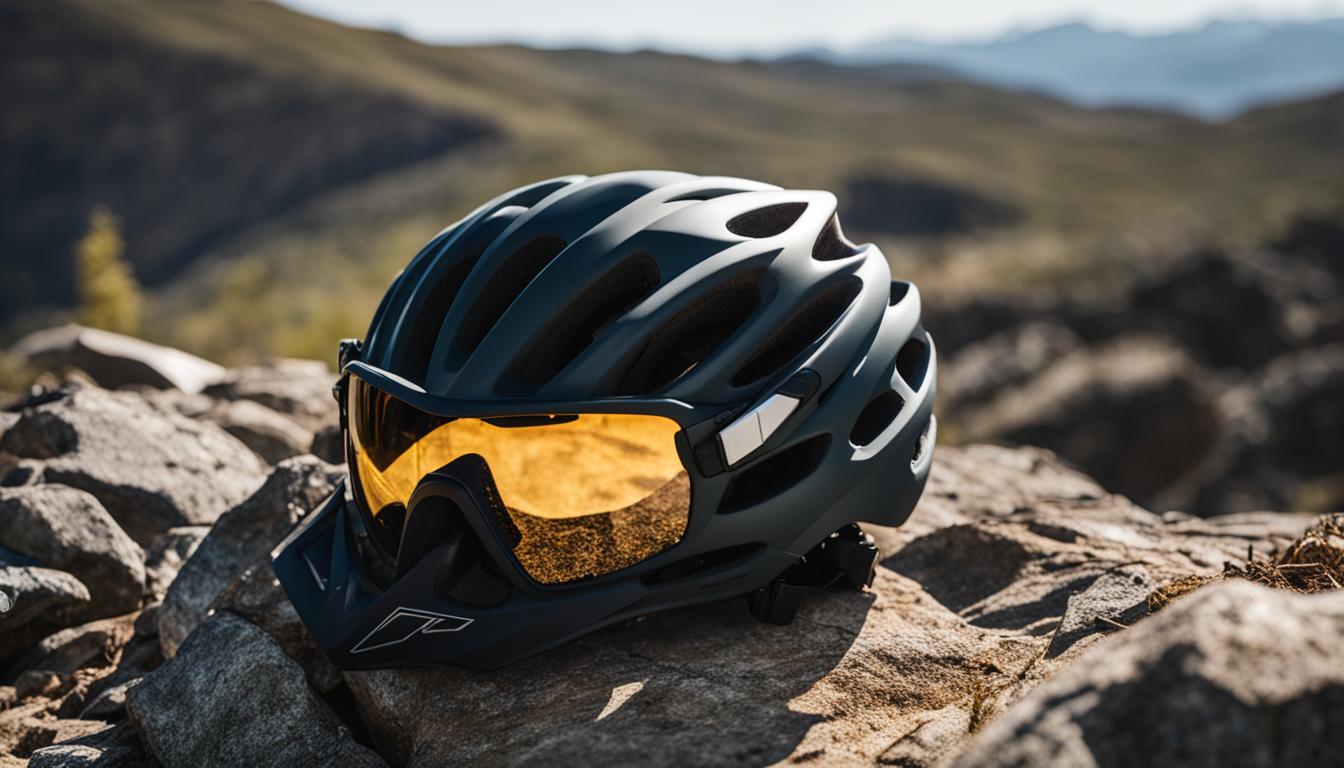Welcome to our beginner’s guide on how to ride a mountain bike safely! Mountain biking is an exhilarating sport that allows you to explore beautiful trails while enjoying the thrill of adventure. However, it’s essential to prioritize your safety and take necessary precautions to avoid accidents and injuries. In this article, we will provide you with valuable tips and guidelines to ensure a safe and enjoyable mountain biking experience.
Read More : The Benefits of Riding a Mountain Bike
Key Takeaways:
- Always wear a helmet and fit it properly to reduce the risk of head injuries.
- Ride within your skill level and stay in control to avoid accidents.
- Wear appropriate mountain biking gear for added protection.
- Get to know the trail before riding and be aware of potential obstacles.
- Choose a bike suitable for the type of trails you will be riding.
Essential Mountain Biking Safety Tips
When it comes to mountain biking, safety should always be your top priority. By following these essential tips, you can ensure a safe and enjoyable riding experience.
1. Wear the Right Safety Equipment
Before hitting the trails, make sure you have the necessary safety gear. This includes a properly fitting helmet to protect your head from injuries. Additionally, invest in riding apparel, gloves, knee and elbow pads, and safety accessories like sunglasses and a bell. Having the right equipment will greatly reduce the risk of injuries.
2. Ride Within Your Skill Level
It’s important to know your limits and ride within your skill level. Pushing yourself too hard can lead to accidents and injuries. Start with easier trails and gradually progress to more challenging ones as your skills improve. Take your time and don’t be afraid to walk difficult sections if you feel uncomfortable.
3. Be Aware of Your Surroundings
Always stay alert and be aware of your surroundings on the trail. Pay attention to potential dangers, obstacles, and other riders. Anticipate blind corners and slow down to maintain control. Understanding the trail you’re riding will help you make informed decisions and avoid accidents.
4. Maintain Your Bike
Regularly maintain your bike to ensure it’s in good working condition. Check the brakes, tires, and gears before each ride. Proper maintenance will prevent mechanical failures and accidents on the trail.
5. Stay Hydrated and Fueled
Long rides can be physically demanding, so make sure you stay hydrated and fueled. Carry enough water and snacks to maintain your energy levels and prevent fatigue. Remember to take breaks when needed and listen to your body.
6. Learn Proper Technique
Take the time to learn and practice proper mountain biking techniques. This includes body positioning, braking, cornering, and descending. Developing good technique will make you a safer and more confident rider.
7. Consider Mountain Bike Insurance
Accidents can happen even with the best precautions. Consider getting mountain bike insurance to protect yourself and your investment. This will provide coverage for any damages to your bike and potential medical expenses.
Mountain Biking Safety Checklist
| Item | Description |
|---|---|
| Helmet | A properly fitting helmet is essential for protecting your head from injuries. Adjust the straps and ensure a snug fit. |
| Protective Gear | Invest in knee and elbow pads, gloves, and body armor to provide extra protection during falls or crashes. |
| First Aid Kit | Carry a first aid kit with essentials like bandages, antiseptic wipes, and pain relievers to treat any injuries that may occur on the trail. |
| Bike Maintenance | Regularly check your bike’s brakes, tires, and gears to ensure they are in proper working condition. This will prevent mechanical failures on the trail. |
| Water and Snacks | Stay hydrated and fueled during your rides by carrying enough water and snacks. This will help maintain energy levels and prevent fatigue. |
Conclusion
Mountain biking is an exhilarating activity that offers numerous benefits, making it a popular choice for outdoor enthusiasts. As a beginner, it is essential to prioritize your safety and follow the necessary precautions to ensure a smooth and enjoyable experience.
By incorporating the mountain biking tips and techniques mentioned in this article, you can start your journey confidently and safely. Remember to always ride within your skill level and gradually progress to more challenging trails as you gain experience.
Investing in the right gear, including a well-fitted helmet and appropriate protective clothing, is crucial for your safety. Understanding the trail and being aware of potential obstacles will also help you navigate effectively.
Throughout your mountain biking journey, continue to learn and develop your skills. Seek guidance from experienced riders, stay hydrated, and listen to your body’s needs. With time, practice, and a focus on safety, you’ll be able to fully embrace the thrill of mountain biking while minimizing the risks.
FAQ
Why is wearing a helmet important while mountain biking?
Wearing a helmet reduces the risk of serious head injury by nearly 70%.
How do I properly fit my helmet?
Adjust the size and chin strap of your helmet for maximum effectiveness.
What gear should I wear for mountain biking?
Wear padded shorts, mountain bike-specific shoes, gloves, and body armor for added protection.
How can I ride safely on the trail?
Get to know the trail before riding it, be aware of potential obstacles and blind corners, slow down for blind corners, and use riding techniques to increase visibility and control.
Is crashing normal while mountain biking?
Yes, crashing is a normal part of mountain biking. Evaluate the risk versus reward before attempting challenging sections.
What type of bike should I choose for mountain biking?
Choose a bike that is suited for the type of trails you will be riding.
Should I have insurance for mountain biking?
Yes, it’s recommended to have health insurance and bicycle insurance to cover any potential expenses.
What should I carry during my mountain bike rides?
Carry a first aid kit to treat any injuries that may occur on the trail.
How can I prevent fatigue during my rides?
Stay hydrated and fueled to maintain energy levels and prevent fatigue.
How can I improve my mountain biking skills?
Take your time, ride within your skill level, be prepared to make mistakes and learn from them, and seek guidance from more experienced riders.

